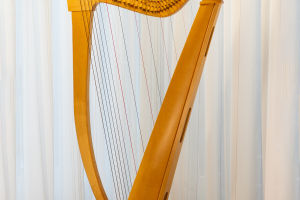In the world of music, the harp stands as a uniquely captivating instrument. With its exquisite tones and celestial sounds, it penetrates deep into the emotions of those who listen, inviting them to immerse themselves in its beauty.
The harp is not merely an instrument; it is a symbol of artistry, representing elegance and grandeur. Let us step into the world of the harp together, exploring its distinct charm.
Melodious Tones
The harp's allure lies primarily in its tones. When notes are delicately plucked on the harp, the gentle yet resonant sound is like a breeze brushing through one's soul. The characteristic of the harp's tones is its sustain, where notes reverberate within the instrument's soundbox, creating an ethereal and layered resonance.
This quality allows the harp to play a unique role in symphony orchestras, often used to perform melodious and emotive movements, such as Debussy's "Clair de Lune" from the "Impressionist" series.
Rich History
The harp's origins trace back to ancient Mesopotamia, where it was initially used as an accompaniment for singing and dancing. Over time, the harp evolved into one of the principal instruments of European court music.
During the medieval and Renaissance periods, the harp was considered a symbol of nobility and royalty, frequently appearing in court concerts and important occasions. Today, the harp maintains its significance in Western music, becoming an indispensable part of orchestras and chamber ensembles.
Legacy of Skill
Playing the harp is no simple task; it requires exceptional skill and expressive prowess.
Harpists must master intricate finger techniques, deftly navigating the strings with both hands to create flowing and beautiful phrases. Moreover, harp performance demands an understanding of music and the ability to convey emotions, allowing musicians to interpret pieces with profound depth.
Cultural Symbolism
Beyond its musical significance, the harp plays a vital role in culture, symbolizing elegance, romance, and splendor. It is often used to depict aristocratic life and romantic atmospheres in literature, movies, and paintings.
For instance, in many classical literary works, the harp is employed to illustrate the lives of nobility and romantic ambiance, such as the Rochester family's exquisite harp in "Jane Eyre." In films, the harp frequently appears in dreamy or romantic scenes, adding emotional hues to the story.
Conclusion
With its unique tones, rich history, exceptional skill requirements, and cultural symbolism, the harp shines as a star among musical instruments. Its graceful and grand appearance conceals layers of meaning and emotion.
As we listen to the harp's melodies, we can sense the depth of time and the blending of emotions, for this is where the harp's enchantment lies. May every music enthusiast find resonance in the harp's notes, experiencing the beauty and emotion that music brings.


